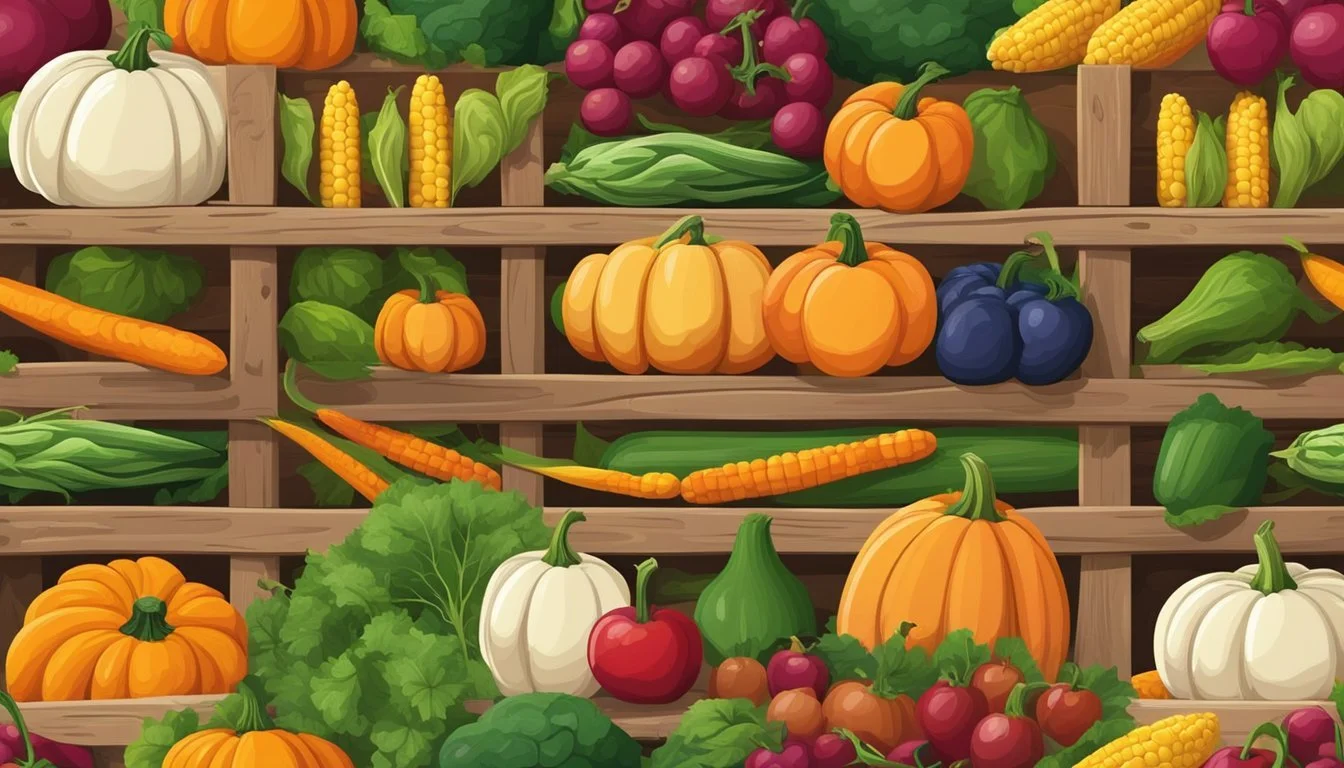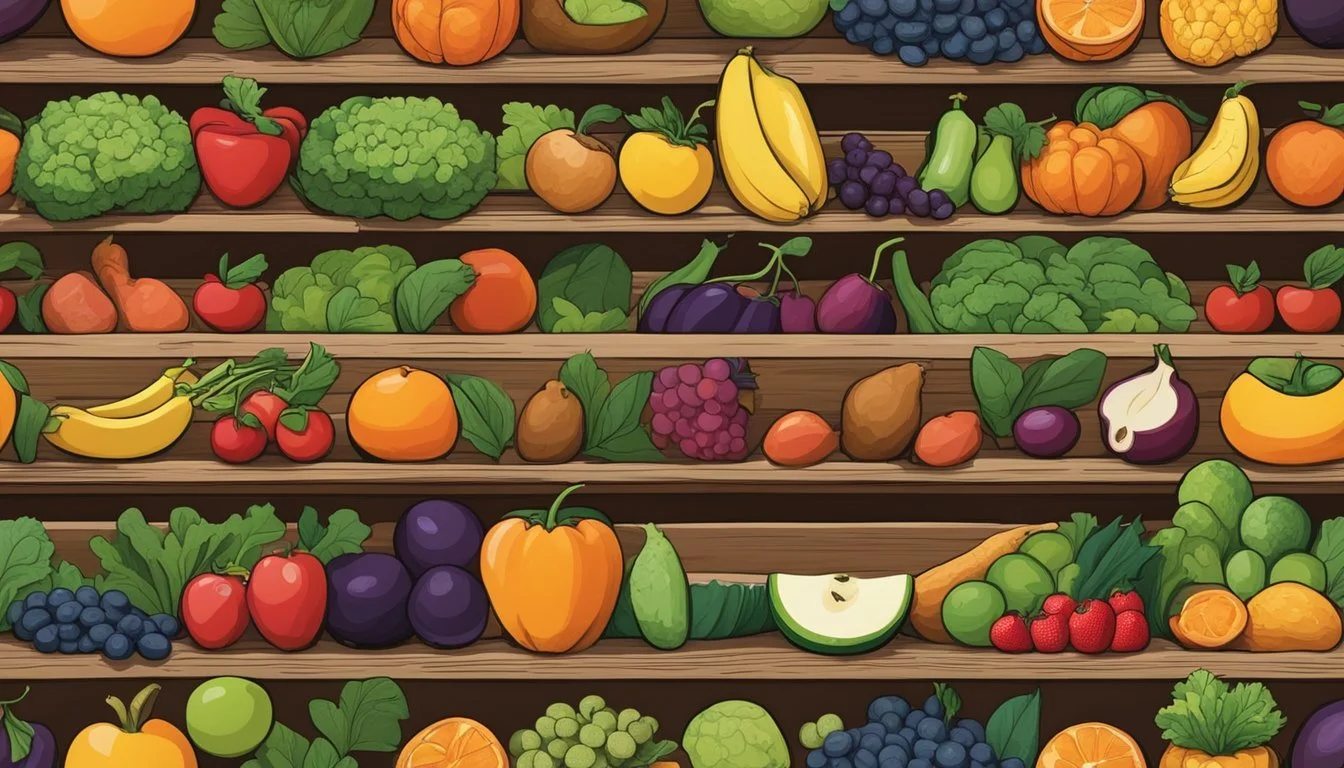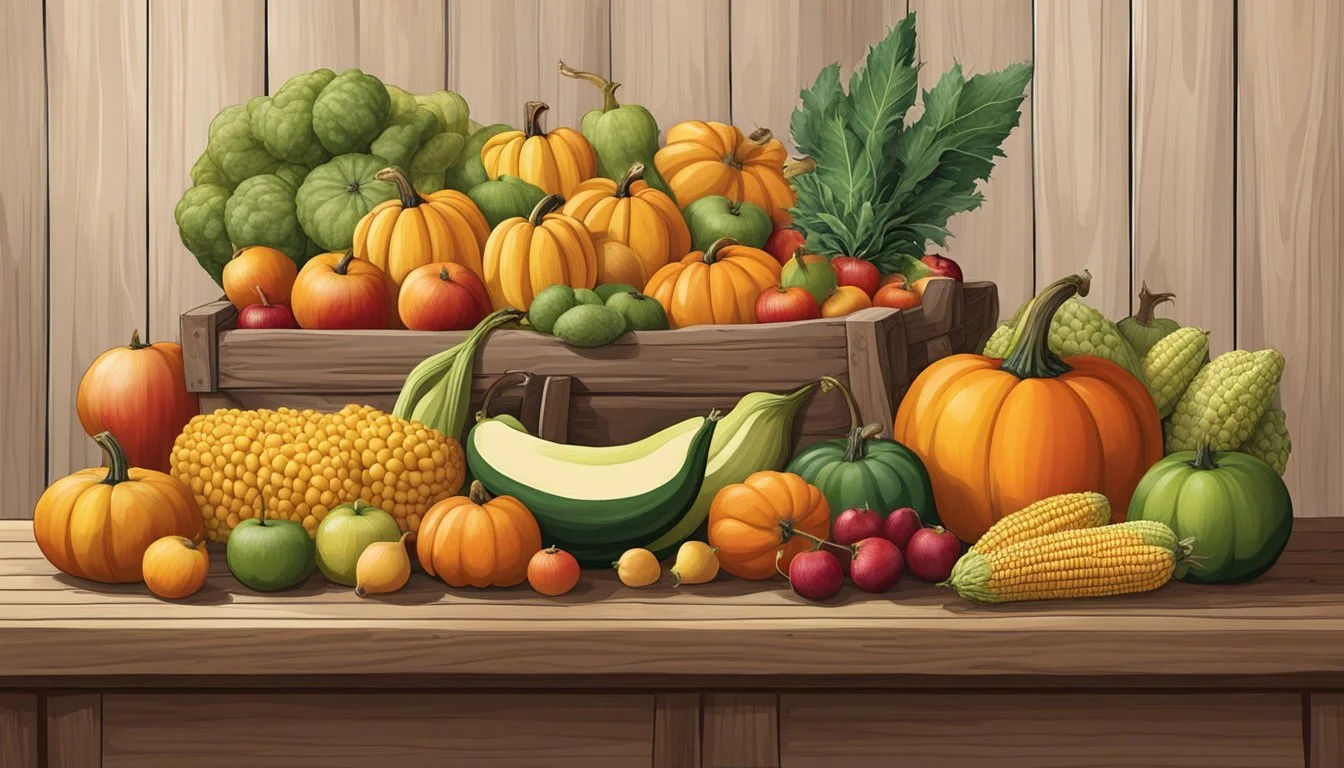Utah Seasonal Fruit & Vegetables in October
A Guide to Autumn Harvest
This Article is Part of our Utah Seasonal Fruit & Veg Calendar
Utah greets October with a welcome transition into autumn, bringing a remarkable change in both the weather and the produce available. Hearty vegetables and a variety of fruits reach their peak during this month, reflecting the state's agricultural diversity. October's cooler temperatures and shorter days contribute to the flavorful ripening of many crops.
Farmers and gardeners throughout Utah harvest a bountiful array of produce in October. The season offers an abundance of root vegetables like beets (how long do beets last?) and carrots (how long do carrots last?), which store energy in their roots and thrive in the dropping temperatures. The state's fruit orchards yield the last of their stone fruits and begin to celebrate the apple harvest, which includes popular varieties like the crisp and sweet Honeycrisp and the versatile Golden Delicious.
Leafy greens such as kale and spinach also make a strong showing during Utah's October harvest, as they can withstand the cooler nights. Broccoli and cauliflower (how long does cauliflower last?) flourish in the milder climate, providing a fresh and nutritious option for local consumers. This month-long window is favorable for those looking to source seasonal produce, and it is an ideal time to visit local farmers markets to experience the best of Utah's fall harvest.
Significance of October Harvest in Utah
In Utah, October is a pivotal month for harvests, reflecting the culmination of the growing season and the preparation for winter. Temperature swings and seasonal transitions have a direct impact.
Roles of Temperature Variations
With the arrival of fall, cooler temperatures in Utah contribute significantly to the final ripening of various fruits and vegetables. Daytime warmth aids in bringing sweetness and flavor to crops, such as apples and pumpkins, while the cooler nights help them mature. This delicate balance often enhances the quality and taste of the produce harvested during this time. Utah experiences varying microclimates, but the temperature in October generally ranges from highs of 55-65°F to lows of 35-45°F, which is conducive for late-season crops.
Transitional Season Changes
October signifies the transition between the warm harvest season of fall and the onset of winter. This not only affects the produce available but also the farming strategies. Producers often rush to gather crops before the first frost, which can vary in timing across Utah's diverse regions. The state sees its first light frosts usually by the end of the month, marking the end of the harvest for many crops. Some vegetables, like kale and Brussels sprouts, may benefit from the cold snap, developing a sweeter taste post-frost. This transition is crucial for farmers to adapt their harvesting techniques and timings to ensure the best quality yield.
Seasonal Fruits Available in October
October in Utah brings a bounty of fresh fruits that are picked at their peak of ripeness. The cooler temperatures not only enhance the sweetness and flavor but also ensure a nutritious harvest.
Top Fruit Picks for October
Apples: Varied species are harvested throughout Utah, offering options from tart Granny Smith to sweet Fuji apples.
Pears: Bartlett and Anjou pears are typically ripe for picking this month, providing juicy choices for fall recipes.
Pumpkin: Although often treated as a vegetable, pumpkin is a fruit that comes into season, heralding the arrival of autumn.
Health Benefits of Seasonal Fruits
Apples: A single medium-sized apple is a good source of dietary fiber and vitamin C.
Pears: Pears contain essential antioxidants and are often recommended for their digestive benefits due to high fiber content.
Pumpkins: Rich in vitamins A and C, pumpkins support the immune system and eye health.
Seasonal Vegetables to Look For
October in Utah is a time of rich harvests, notably with a diverse array of vegetables ripe for the picking. Hearty root vegetables come into season, offering consumers a bounty of earthy flavors and nutrition.
Root Vegetable Harvest
Squash: In October, varieties of winter squash such as butternut, acorn, and spaghetti are readily available. These are versatile in cooking, perfect for both sweet and savory dishes.
Broccoli: This nutrient-dense vegetable is harvested until the first heavy frost, presenting a fresh, green option in the autumn palette of produce.
Carrots: Their sweet, crunchy texture makes them a favorite. Carrots harvested in the fall can have an enhanced sweetness, making them ideal for both raw and cooked applications.
Pumpkins: Synonymous with fall in Utah, pumpkins are not only a symbol of the season but are also rich in vitamins and can be used in a variety of dishes from pies to soups.
Beets: These vibrant root vegetables offer a sweet, earthy flavor to a variety of dishes. They can be roasted, boiled, or eaten raw and are full of essential nutrients.
Cabbage: A staple in many fall recipes, cabbage is versatile and can be used in stews, salads, or fermented into sauerkraut (how long does sauerkraut last?).
Cauliflower: Valued for its adaptability in recipes and nutritional content, cauliflower is abundant during October.
Chard: Chard, or Swiss chard, offers a mild, spinach-like flavor and is full of vitamins and minerals. It's great sautéed or added to soups and stews.
Kale: This leafy green thrives in cooler temperatures, which makes its flavor more pronounced in the October harvest.
Lettuce: Cooler weather is ideal for varieties of lettuce, which remain crisp and refreshing through the fall.
Eggplant: While reaching the end of its season, eggplant is still available in October, adding richness to dishes with its unique texture and flavor.
In October, Utah's farms are abundant with these and other seasonal vegetables, inviting a shift to warm, nourishing meals in anticipation of the colder months ahead.
Exploring Local Farmers Markets
Utah's farmers markets are vibrant community hubs where the air is often filled with the scent of fresh produce. They are a celebration of the state's agricultural bounty, offering a direct connection to the local food scene.
Utah's Farmers Market Atmosphere
The farmers markets across Utah are characterized by a lively atmosphere where community members converge. They provide a bustling, social environment where visitors can enjoy the crisp autumn air and the sweet aroma of harvested fruits and vegetables. Stalls are typically adorned with colorful displays of the season's bounty, and the sound of friendly chatter punctuates the ambiance.
Direct-from-Farm Freshness
Local farmers markets are the go-to destinations for fresh, state-grown produce. In October, these markets showcase items such as:
Fruits: { Apples, Pears }
Vegetables: { Squash, Pumpkins, Carrots, Beets }
This direct-from-farm freshness ensures that consumers get the most flavorful and nutrient-rich produce available. Patrons appreciate the chance to meet and support the farmers who work tirelessly to cultivate and harvest their crops.
Preparation and Storage Tips for Seasonal Produce
In Utah's October, proper preparation and storage are crucial for extending the lifespan of seasonal fruits and vegetables and ensuring their freshness.
Extending Shelf Life of Harvested Produce
One can maximize the longevity of produce like potatoes, onions, and garlic by keeping them in a cool, dark place with good ventilation. For example, storing potatoes away from direct sunlight helps prevent greening and the production of solanine, a natural toxin that can develop when potatoes are exposed to too much light. Onions and garlic also benefit from similar conditions, ideally in a mesh bag or basket to promote air circulation which can extend their shelf life.
Best Practices for Produce Storage
Fruits and vegetables require different storage methods to preserve their freshness. Root vegetables such as beets and carrots keep well in a cold, humid environment, which could be replicated by storing them in perforated plastic bags in the crisper drawer of a refrigerator.
Celery: (how long does celery last?) Retains its crispness when wrapped in aluminum foil and stored in the refrigerator crisper drawer.
Leeks: Should be loosely wrapped in plastic to retain moisture and placed in the crisper drawer of the refrigerator.
When it comes to herbs, they last longer when stored with stems submerged in a glass of water, covered loosely with a plastic bag, and refrigerated.
Storage Table
Here is a quick reference table for some common produce:
Produce Storage Method Expected Shelf Life Potatoes Cool, dark, ventilated place 2-3 months Onions Mesh bag in cool, dark area 1-2 months Garlic Basket in cool, dry location 3-5 months Celery Wrapped in foil in the fridge 2-4 weeks Leeks Plastic wrap in the fridge 1-2 weeks
It's important to note that all produce should be checked regularly for spoilage and used promptly for the best flavor and nutritional value.
Culinary Ideas for October's Bounty
October's bounty in Utah brings a medley of flavors and opportunities for creative cooking. Utilizing the natural sweetness and diverse varieties of seasonal produce, one can craft comforting recipes and preserve the harvest to enjoy year-round.
Simple and Heartwarming Recipes
Sweet Potatoes: Rich in taste and versatility, sweet potatoes (What wine goes well with sweet potatoes?) are superb for a wide range of dishes. They can be roasted to perfection with a touch of honey and salt, mashed to create a silky smooth side dish, or sliced and layered in a savory-sweet pie.
Recipe Suggestion:
Honey-Roasted Sweet Potatoes
Ingredients: Sweet potatoes, honey, olive oil, salt, and pepper
Directions: Cube and toss sweet potatoes with honey, oil, and seasoning. Roast until tender.
Jam-Making with Stone Fruits: Late-season stone fruits like cherries and plums make exquisite jams and preserves. Adding modest amounts of sugar while cooking the fruit draws out its natural sweetness and allows the full flavor profile to shine.
Jam Recipe Framework:
Ingredients: Stone fruit, sugar, lemon juice, pectin (how long does pectin last?) (as needed)
Directions: Combine ingredients in a pot, simmer until thickened, and store in sterilized jars.
Preserving the Harvest through Canning
Sauces from Fresh Tomatoes: As the tomato season winds down, one can capture the essence of fresh tomatoes in homemade sauces. Canning these sauces secures a reserve of rich, summer flavor well into winter months. Varieties like Roma or San Marzano are often preferred for their thicker flesh and lower water content.
Sauce Canning Basics:
Peel and seed tomatoes.
Cook down with herbs, salt, and a pinch of sugar.
Can using a water bath or pressure canner, following safety guidelines.
Fruit Preserves: The natural pectin in many of October's fruits, particularly apples and stone fruits, lends itself well to canning as preserves or pie fillings. Balancing fruit with sugar and acid ensures both taste and preservation qualities are optimal.
Preserve Canning Process:
Prepare fruit by pitting and cutting as needed.
Combine with sugar, lemon juice, and spices in a pot; cook to desired consistency.
Can in sterilized jars, leaving appropriate headspace and secure with lids and bands.
Sustainable Practices and Support for Local Agriculture
In Utah, October heralds the harvest of a diverse selection of fruits and vegetables, driving a focus on sustainable practices. Consumers, farms, and the state work in tandem to support organic and sustainable farming, ensuring the continuity of community health and local agriculture.
Understanding Organic and Sustainable Farming
Sustainable agriculture integrates three main objectives: environmental health, economic profitability, and social equity. Utah farmers implementing sustainable farming practices aim to:
Maintain and improve soil health through organic matter enrichment and conscientious land management.
Minimize water usage by utilizing drip irrigation and other water-efficient techniques.
Reduce the carbon footprint through minimal use of fossil fuels and by promoting local sales, cutting down on long-distance transportation.
Organic farming is a subset of sustainable agriculture strictly regulated by state and federal standards that prohibits the use of synthetic pesticides and fertilizers, GMOs, and requires maintaining a high level of biodiversity. Organic farms contribute to a healthier community by providing foods that support individuals' well-being and the environment.
Farmers' markets and community-supported agriculture (CSA) programs facilitate direct support from the community to these farms. By purchasing organic and sustainable products from local farms, the community engages in a cycle of mutual benefit that bolsters the state's commitment to a sustainable future.
Conclusion
October in Utah showcases a rich harvest of fruits and vegetables, reflecting the region's agricultural diversity. Markets brim with fresh produce, significantly enhancing the local culinary scene. Consumers can expect a variety of fruits and vegetables that are not only local but also at the peak of their flavor and nutritional value.
In terms of fruits, one can find apples, pears, and quince ripe for the picking. The cooler temperatures sweeten these fruits, making them ideal for both raw consumption and culinary uses such as pies and preserves. Vegetables like pumpkins, squash, and sweet potatoes are also abundant, offering warm, earthy flavors emblematic of autumnal dishes.
Here is a brief list of fruits and vegetables typically available in Utah during October:
Fruits:
Apples (various types)
Pears
Quince
Vegetables:
Pumpkins
Winter squash
Sweet potatoes
Beets
Carrots
Farmers and gardeners in Utah must remain mindful of the first frost, as it signals the winding down of the harvest season. However, with the local knowledge and agricultural practices adapted to the unique Utah climate, they capitalize on October's temperate weather to deliver quality produce to the community.
Patrons are encouraged to visit local farmers' markets to support regional agriculture and to enjoy what the season has to offer. Embracing these seasonal selections not only bolsters the local economy but also ensures a connection to the region's natural harvest cycle.










